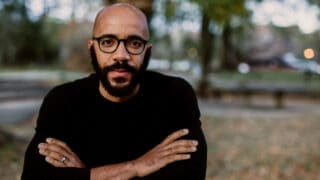The Lavin Agency Speakers Bureau
A speakers bureau that represents the best original thinkers,
writers, and doers for speaking engagements.
A speakers bureau that represents the best original thinkers,
writers, and doers for speaking engagements.
The future of data is about to be written—and it’s up to us to imagine a more just data democracy.
Our data is constantly surveilled and sold in the interest of profit and power. But the future of data has yet to be written, says JER THORP—and we all have a say in making it more just and democratic. Sought after by the likes of Twitter, Microsoft, and The New York Times, Thorp is an in-demand data artist revolutionizing the way we consume information. In his book Living in Data, he helps us redefine what data is, who gets to speak its language, and how we can use it to better serve us. In an age of ChatGPT and generative AI, he shows us the possibilities and limits of technology, and helps us understand the future we’re all stepping into. We can stop passively inhabiting data, he says, and become active citizens of it.
“We hear every day how data is affecting our world. But Living in Data is the first time we can really feel it. In this book, Jer Thorp has the technical expertise of a coder but the soul of a storyteller, and the result is a highly accessible, even stirring, view into the often-invisible systems that shape our lives.”— Anil Dash, CEO, Glitch
As a data artist, Jer Thorp reveals the human stories within endless scrolls of raw information, expressing trends, movements, and economics through vibrant graphics (and public art) seen by hundreds of millions of people. He is the first ever Innovator-in-Residence at the Library of Congress, the former Data Artist-in-Residence at The New York Times, a National Geographic Fellow, and the Artist-in-Residence at the Museum of Modern Art. Provocative, visceral, and enlightening, Thorp’s first book Living in Data transcends facts and figures to tell real, human stories—illustrating our current relationship with data, and imagining what the future might hold. Will data become truly public and accessible? Can it help institutions better serve their communities? “Living in Data offers no easy fix. Rather, it shows that the potential for change lies within us: in our human, fallible, hopeful mind,” writes MoMA’s Curator of the Department of Architecture & Design, Paola Antonelli.
Thorp is also a brilliant business speaker. He tracks consumers in ways few digital experts can—contextualizing their behavior, personalizing the anonymous, and frequently validating the work of digital marketers.
On stage, Thorp illuminates the exciting potential of what his projects mean for society. “The work we do with data is not passive. It affects people’s lives and wellbeing,” he says. Data is about meaningful connections, as Thorp explored in his moving 9/11 memorial at Ground Zero, for which he wrote a program that organized the names of victims not by alphabetical order, but by relationships—putting coworkers next to coworkers, and brothers next to brothers. From 2013 to 2017, Thorp operated The Office for Creative Research, where he and his team implemented ingenious projects—like counting all the endangered elephants across the African continent, which helped influence ivory poaching policies. In February of 2017, amidst a rising tide of xenophobia, The OCR installed a sculpture in Times Square that depicted New York City’s rich history of immigration. A mesmerizing, funny, and socially engaged activist—often working at the juncture of social justice, technology, marketing, and art—Thorp reveals what we normally, and understandably, could never see in big data. And he makes it look cool.
Thorp has been at the forefront of Artificial Intelligence research for years. He coded his first neural network over a decade ago, and is now involved with the AI Now Institute (NYU) and Knowing Machines (NYU & USC). In talks, he draws on his unique career and expertise to show us what AI like ChatGPT can and can’t do, what it’s made of, and how we can work alongside it to develop a more productive, democratic, and flourishing future.
Native to Vancouver, Thorp now lives in New York City, where he teaches in NYU’s Interactive Telecommunication Program. He has been a vocal advocate around data, ethics, and privacy, spearheading a project with The OCR called Floodwatch, a collective ad monitoring tool that empowered individuals to see how advertisers were profiling them (often inaccurately, and unfairly). The aim was to help combat discriminatory practices, such as targeting specific demographics to fill a housing development over others. His award-winning work has been exhibited, read, and implemented in Europe, Africa, Asia, North America, and South America. He has over a decade of teaching experience, and has presented at The Ford Foundation in New York City, the National Academies, and the Library of Congress.
We had an amazing time with you! It was fun and interesting and easygoing. Thank you! And the event was a huge success! People’s comments are raves. They had never heard this view about Big Data and it made total sense to them. Huge impact!
The Mob, Brazil
Author of The State Must Provide: The Definitive History of Racial Inequality in American Higher Education Staff Writer at The Atlantic

#1 New York Times Bestselling Author of How the Word Is Passed and Above Ground Atlantic Staff Writer
CEO of Phylagen, Inc. TED Senior Fellow

Founder of Vision & Justice Harvard Associate Professor Author of The Rise and The Unseen Truth

Instant New York Times Bestselling Author of The Story of Art Without Men 2021 Forbes 30 under 30 Europe Guardian Columnist Art Historian and Curator
Award-Winning Toy Designer of the World-Renowned Rigamajig Founder and Principal Designer at Toy Company Heroes Will Rise

Author of Grit, the #1 New York Times Bestseller | Pioneering Researcher on Grit, Perseverance, and the Science of Success

Pulitzer Prize-Winning Creator of The 1619 Project | Executive Producer of the Emmy Award-Winning 1619 Project Hulu Docuseries | MacArthur Genius
Nike's Former Chief Marketing Officer | Author of Emotion by Design

New York Times Bestselling Author Of All Boys Aren’t Blue and We Are Not Broken | Emmy Nominee | LGBTQIA+ Activist
CEO of The Atlantic | Former Editor-in-Chief of WIRED

What is it like to live in data? To be a human in a world where every action is instrumented, where our jobs and our families and our love lives are increasingly quantified? In this session, Jer Thorp, National Geographic Explorer and former data artist in residence at The New York Times, will share a series of projects by The Office for Creative Research which examine the fast-changing relationship between data and culture. From visualizations to performances and public art, Jer will explore ways in which we can bring data closer to humans, and propose ways that we can all work to make a more livable data world.


We all know that data visualization can be a powerful tool for understanding. But what about data sonification? Or data sculpture? Or data performance?
Jer Thorp’s career as a data artists has brought him from the bustling newsroom of The New York Times to a submersible in the inky depths of the Gulf of Mexico; from the gleaming white galleries of MoMA to the divided streets of St. Louis. In this talk, Jer will examine how artists can insert themselves into data systems to provoke, interrogate and examine. Jer will discuss his own evolving practice as a Data Artist, and will propose ways for data visualization practitioners to move beyond charts and graphs.

In this talk, Jer Thorp shares his beautiful and moving data visualization projects, helping audiences put abstract data into a human context. From graphing an entire year’s news cycle, to mapping the way people share articles across the internet, to the 9/11 Memorial in Manhattan, Thorp’s cutting-edge visualizations use technology and data to help us learn about the way we use digital technologies, become more empathetic in the data age, and ultimately, tell the story of our lives. How can understanding the human side of data lead to innovation and effective change? What value is there in the novel and interactive approaches to data visualization? And, what are the business applications of creative data-focused research? Thorp teaches audiences how adding meaning and narrative to huge amounts of data can help people take control of the information that surrounds them, and revolutionize the way we utilize data.